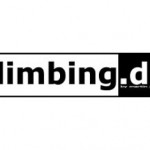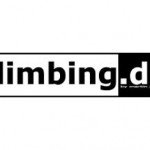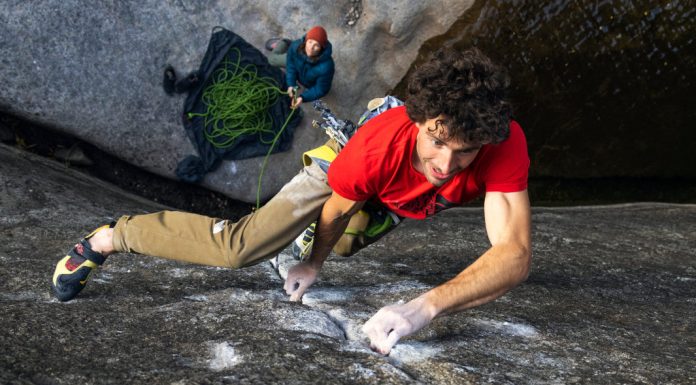Blind Vision E10 7b  On the 6c crux on the upper wall, the Friend Zero #2 can be seen on the right rope, the remaining gear is at the height of the ledge (out of shot). Photo taken from video footage filmed by Mark Turnbull. This route takes a line through the buttress between Green Gut and Big Crack at Froggatt. It starts up Jerry Moffatt?s famous boulder problem ?Slingshot? to a good ledge, then climbs the wall directly above. The route is partially protected by good gear on the halfway ledge, just above the ledge are placements for two reasonably solid brass nuts, and about four meters above is a narrow slot which accepts a ?Zero? Friend, size 2, due to it?s ?progression only? rating, it is questionable as to whether it would hold a leader fall, but is much better than nothing (!) The initial section of Slingshot involves a highly dynamic move to a small finger edge that is just big enough to match on. After that another throw out right to a good hold is made, but at this point there are no foot holds, a few powerful pulls and a bunched up rock-over gain the ledge.I had my harness and reduced rack thrown up to me at that point, and built a ?bomb shelter?. Leaving the ledge is a lonely experience, the climbing is not particularly hard, but technical and off-balance. The first outing above the ledge is to place the Zero. The miniature cam is place at full reach from an undercling, a powerful, and precariousposition where you have to think calmly and seat the cam well ? there is less than 1mm margin for error in the placement, and there is certainly a ?right way up? for the gear. After that you reverse the moves to the ledge, the last move to the ledge is- for some reason particularly difficult, on the lead I spent about a minute hanging in working it out ? although quite safe it would be a really stupid place to fall and have to start all over again. Back on the ledge, now with a rope clipped half way up the upper wall. The upper wall in total, is 7c+, not strenuous, but technical, and sustained, the climbing is quite insecure, and there are a few possible ways of doing it. The crux move involves a long reach from the same undercling that you place the gear from, but to make the further reach the feet are higher, and even less secure. The vertical span is almost the limit of my reach, and wins only a sloping edge, wide enough to match until both hands are on it. The original way I tried this was a dyno for a reasonable hold for the right hand, from here the sequence to the top is natural, and flows really well, problem is ? I hate dynoing. The move was insecure the say the least, and it was only in the latest stages of working the route that I unlocked a devious sequence that is one of the most satisfying pieces of climbing I have every done. It involves a static lock to a hold that, when you look at it doesn?t exist, but if you close your eyes and feel, it actually works by using a good thumb gaston (reverse sidepull) combined with a crozzly patch for your fingers. It?s not much, and the feet are rubbish too, but combined with rigid body tension, is enough to get your right hand onto the next hold ? the one you would otherwise dyno for. It?s about UK 6b to the top after than move, maybe easier ? it?s hard to judge really. However it is quite insecure and the thought of falling is just not an issue. On the lead the crux flowed perfectly, but the last few moves stopped me, the holds had been wet for months, and I wasn?t very familiar with them, so I just paused, it felt like ages, but was probably only a few seconds, at this point, because the climbing was easier, I was more in manual control, which was a lot more scary that the auto-pilot that engages when you?re doing hard moves in a series position.Then I was at the top.Previously, I?ve felt a real anti-climax on headpoint routes, because they never felt like ?climbing?, just going through the motions without any sense of uncertainty. This strongly influenced the name I gave to my previous new route on Froggatt ? Soul Doubt (E8 6c)? I wasn?t sure what my motivation was for climbing it, more just wanting to get the first ascent than the search for a personal challenge, but this time it was different, I knew I?d bitten off a project that stretched me to the limit, and I felt like I?d really been climbing. By the time I lead the route, I had spent about ten days over several months working the various sections. I had trained specifically for the powerful moves on Slingshot by jumping up to crimps in a finger board in my (well, John Arran?s actually) kitchen ? you can tell something had when you have to train that specifically ? and hat off to Jerry Moffatt for doing it all that time ago (I 100% credit Jerry with the first ascent of Slingshot, and, as a boulder problem don?t think it matters a damn whether you use a rope or a bunch of bouldering pads and spotters). On the day it was well below freezing, and generally a perfect sunny winter?s day. The first ascent was filmed my Mark Turnbull. The Protection An odd route to protect ? the start (Slingshot) was climbed unroped with three spotters and four bouldering pads. I had previously considered throwing a rope over the sapling on the ledge and protecting it that way, but felt that my ascent would be questioned, so scrapped the idea ? it was actually physically easier to do it that way, as there was no rope in the way ? and having done Slingshot twice with a top-rope ? feel fairly qualified to judge it. The top was protected by double ropes, a 10mm rope through the low gear, and an 8mm rope through the top Zero 2. The plan was that if I fell from the upper wall, belayer 1 (Adrian Baxter) would run to take in the slack at the same time as belayer 2 (Chris Doyle) gave a super-dynamic belay, so that if they Friend ripped, I would stand a chance of being stopped by the brass nuts. Fortunately I didn?t have to test any of this. The belay team was similarly relieved.The Grade A hard one to grade, I´m not very familiar with bouldering grades, as I don?t do much bouldering. I will assume Slingshot is Font 8a (although it is given font 8b in the Rockfax grit guide, and appears elsewhere as font 8a+) and UK7a (though it is consistently given 7b in all the guides I?ve seen it in). On the basis that Jerry Moffatt?s highball boulder problem to the right (Chequers Groove) was graded E8 7a at font 7c+, it?s not unreasonable to give Slingshot E8/9 in its own right ? it would probably get f8b (E8) with bolts in. The upper wall is much simpler, UK6c crux, f7c+, but insecure and bold, a similar proposition to the lower wall in terms of ?E? grade, but at the complete opposite end of the spectrum in terms of style. So a game of two halves. After listening to a lot of opinions, in particular John Arran, and Neil Gresham, who are two of only 3 people to have climbed E10 on gritstone, I´m proposing E10. Seb Grieve, who had previously spent a lot of effort working the line also concurred with the grading. As to the technical grade, Slingshot has the hardest moves, and has been 7b in each guide it appears in, so I can only go with that, as an onsight technical grade and as such it is the first E10 7b. I wasn?t able to talk with Mo in the last few days, but the last time I spoke with him (after I top-roped it the first time) he was asking me what I thought ? so obviously didn?t have a strong opinion. Some people have attacked this grading (on the web fora) on the basis that two E9?s with a rest ledge between them doesn?t make an E10, but in this case, with two wildly different climbing strengths needed to do both parts of the route, the combined difficulty is far and away above the sum of its parts. Also, the fact that so many of the best gritstone climbers have tried this line over the years suggests that it is a hard route to develop sufficient all-round strength and mental capability for, and so I feel safe that E10 7b is the appropriate grade.
On the 6c crux on the upper wall, the Friend Zero #2 can be seen on the right rope, the remaining gear is at the height of the ledge (out of shot). Photo taken from video footage filmed by Mark Turnbull. This route takes a line through the buttress between Green Gut and Big Crack at Froggatt. It starts up Jerry Moffatt?s famous boulder problem ?Slingshot? to a good ledge, then climbs the wall directly above. The route is partially protected by good gear on the halfway ledge, just above the ledge are placements for two reasonably solid brass nuts, and about four meters above is a narrow slot which accepts a ?Zero? Friend, size 2, due to it?s ?progression only? rating, it is questionable as to whether it would hold a leader fall, but is much better than nothing (!) The initial section of Slingshot involves a highly dynamic move to a small finger edge that is just big enough to match on. After that another throw out right to a good hold is made, but at this point there are no foot holds, a few powerful pulls and a bunched up rock-over gain the ledge.I had my harness and reduced rack thrown up to me at that point, and built a ?bomb shelter?. Leaving the ledge is a lonely experience, the climbing is not particularly hard, but technical and off-balance. The first outing above the ledge is to place the Zero. The miniature cam is place at full reach from an undercling, a powerful, and precariousposition where you have to think calmly and seat the cam well ? there is less than 1mm margin for error in the placement, and there is certainly a ?right way up? for the gear. After that you reverse the moves to the ledge, the last move to the ledge is- for some reason particularly difficult, on the lead I spent about a minute hanging in working it out ? although quite safe it would be a really stupid place to fall and have to start all over again. Back on the ledge, now with a rope clipped half way up the upper wall. The upper wall in total, is 7c+, not strenuous, but technical, and sustained, the climbing is quite insecure, and there are a few possible ways of doing it. The crux move involves a long reach from the same undercling that you place the gear from, but to make the further reach the feet are higher, and even less secure. The vertical span is almost the limit of my reach, and wins only a sloping edge, wide enough to match until both hands are on it. The original way I tried this was a dyno for a reasonable hold for the right hand, from here the sequence to the top is natural, and flows really well, problem is ? I hate dynoing. The move was insecure the say the least, and it was only in the latest stages of working the route that I unlocked a devious sequence that is one of the most satisfying pieces of climbing I have every done. It involves a static lock to a hold that, when you look at it doesn?t exist, but if you close your eyes and feel, it actually works by using a good thumb gaston (reverse sidepull) combined with a crozzly patch for your fingers. It?s not much, and the feet are rubbish too, but combined with rigid body tension, is enough to get your right hand onto the next hold ? the one you would otherwise dyno for. It?s about UK 6b to the top after than move, maybe easier ? it?s hard to judge really. However it is quite insecure and the thought of falling is just not an issue. On the lead the crux flowed perfectly, but the last few moves stopped me, the holds had been wet for months, and I wasn?t very familiar with them, so I just paused, it felt like ages, but was probably only a few seconds, at this point, because the climbing was easier, I was more in manual control, which was a lot more scary that the auto-pilot that engages when you?re doing hard moves in a series position.Then I was at the top.Previously, I?ve felt a real anti-climax on headpoint routes, because they never felt like ?climbing?, just going through the motions without any sense of uncertainty. This strongly influenced the name I gave to my previous new route on Froggatt ? Soul Doubt (E8 6c)? I wasn?t sure what my motivation was for climbing it, more just wanting to get the first ascent than the search for a personal challenge, but this time it was different, I knew I?d bitten off a project that stretched me to the limit, and I felt like I?d really been climbing. By the time I lead the route, I had spent about ten days over several months working the various sections. I had trained specifically for the powerful moves on Slingshot by jumping up to crimps in a finger board in my (well, John Arran?s actually) kitchen ? you can tell something had when you have to train that specifically ? and hat off to Jerry Moffatt for doing it all that time ago (I 100% credit Jerry with the first ascent of Slingshot, and, as a boulder problem don?t think it matters a damn whether you use a rope or a bunch of bouldering pads and spotters). On the day it was well below freezing, and generally a perfect sunny winter?s day. The first ascent was filmed my Mark Turnbull. The Protection An odd route to protect ? the start (Slingshot) was climbed unroped with three spotters and four bouldering pads. I had previously considered throwing a rope over the sapling on the ledge and protecting it that way, but felt that my ascent would be questioned, so scrapped the idea ? it was actually physically easier to do it that way, as there was no rope in the way ? and having done Slingshot twice with a top-rope ? feel fairly qualified to judge it. The top was protected by double ropes, a 10mm rope through the low gear, and an 8mm rope through the top Zero 2. The plan was that if I fell from the upper wall, belayer 1 (Adrian Baxter) would run to take in the slack at the same time as belayer 2 (Chris Doyle) gave a super-dynamic belay, so that if they Friend ripped, I would stand a chance of being stopped by the brass nuts. Fortunately I didn?t have to test any of this. The belay team was similarly relieved.The Grade A hard one to grade, I´m not very familiar with bouldering grades, as I don?t do much bouldering. I will assume Slingshot is Font 8a (although it is given font 8b in the Rockfax grit guide, and appears elsewhere as font 8a+) and UK7a (though it is consistently given 7b in all the guides I?ve seen it in). On the basis that Jerry Moffatt?s highball boulder problem to the right (Chequers Groove) was graded E8 7a at font 7c+, it?s not unreasonable to give Slingshot E8/9 in its own right ? it would probably get f8b (E8) with bolts in. The upper wall is much simpler, UK6c crux, f7c+, but insecure and bold, a similar proposition to the lower wall in terms of ?E? grade, but at the complete opposite end of the spectrum in terms of style. So a game of two halves. After listening to a lot of opinions, in particular John Arran, and Neil Gresham, who are two of only 3 people to have climbed E10 on gritstone, I´m proposing E10. Seb Grieve, who had previously spent a lot of effort working the line also concurred with the grading. As to the technical grade, Slingshot has the hardest moves, and has been 7b in each guide it appears in, so I can only go with that, as an onsight technical grade and as such it is the first E10 7b. I wasn?t able to talk with Mo in the last few days, but the last time I spoke with him (after I top-roped it the first time) he was asking me what I thought ? so obviously didn?t have a strong opinion. Some people have attacked this grading (on the web fora) on the basis that two E9?s with a rest ledge between them doesn?t make an E10, but in this case, with two wildly different climbing strengths needed to do both parts of the route, the combined difficulty is far and away above the sum of its parts. Also, the fact that so many of the best gritstone climbers have tried this line over the years suggests that it is a hard route to develop sufficient all-round strength and mental capability for, and so I feel safe that E10 7b is the appropriate grade.


![[VIDEO] Alexander Megos: URSUS | The days after the send URSUS | The days after the send (c) Alexander Megos](https://www.climbing.de/wp-content/uploads/2024/03/youtube_WCZVR9-tZTc-218x150.jpg)

![[VIDEO] Stefano Ghisolfi: ALL my secrets about ENDURANCE Stefano Ghisolfi: ALL my secrets about ENDURANCE (c) Stefano Ghisolfi](https://www.climbing.de/wp-content/uploads/2024/03/youtube_xlQ2OreHL60-218x150.jpg)
![[VIDEO] THE FULL JOURNEY 9B FA by Alexander Megos THE FULL JOURNEY 9B FA by Alexander Megos (c) Alexander Megos](https://www.climbing.de/wp-content/uploads/2022/12/youtube_QwjykRehg7M-218x150.jpg)
![[VIDEO] MEGATRON V17 MEGATRON V17 (c) mellow](https://www.climbing.de/wp-content/uploads/2022/12/youtube_f_MniTA8MYU-218x150.jpg)
![[VIDEO] Moulin Rouge (7b) Free Solo | Jonas Hainz Moulin Rouge - Free Solo (c) Jonas Hainz](https://www.climbing.de/wp-content/uploads/2022/10/youtube_UQs4KNRBHss-218x150.jpg)
![[VIDEO] adidas Rockstars 2014 - Teaser - Porsche Arena Stuttgart](https://www.climbing.de/wp-content/uploads/2014/12/vimeo_105536497-150x150.jpg)
![[VIDEO] 8b+ trad in der Pfalz](https://www.climbing.de/wp-content/uploads/2014/12/vimeo_94038928-150x150.jpg)










